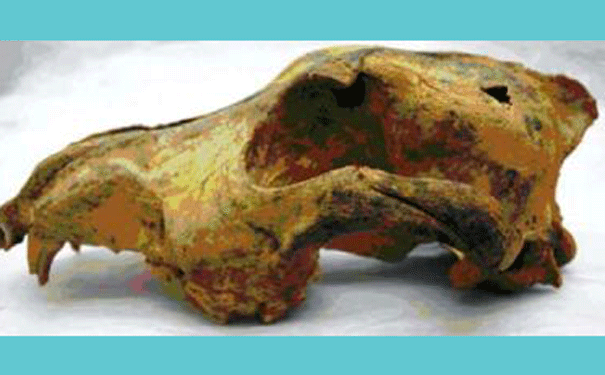
A 33,000-year-old dog skull found in Siberia presents some of the oldest evidence of dog domestication.
The Siberian skull discovered in a cave in the Altai Mountain suggests, together with an equally ancient dog remains found in a Belgium cave in 2011, that domestication of dogs may have occurred repeatedly in different geographic locations rather than with a single domestication event. In other words, today’s dogs might have originated from more than one ancient ancestor, contrary to what some DNA evidence had previously indicated.
Based on their morphological characteristics, the researchers asserted that both skulls belonged to domesticated species. “Essentially, wolves have long, thin snouts and their teeth are not crowded, and dog domestication results in this shortening of the snout and widening of the jaws and crowding of the teeth,” said Greg Hodgins, a researcher at the University of Arizona’s Accelerator Mass Spectrometry Laboratory.
The Siberian skull is extremely well preserved. This has allowed scientists to make multiple measurements of the teeth and jawbone, something that is not be possible on less well-preserved remains. “The argument that it is domesticated is pretty solid,” Hodgins said. “What’s interesting is that it doesn’t appear to be an ancestor of modern dogs.”
The scientists used radiocarbon dating to determine the age of the skull. The results suggest that it predates the last ice age, which occurred between 26,000 and 19,000 years ago. Because the ice sheets severely disrupted life for humans and animals, it is believed that neither the Belgium nor the Siberian lineages survived the severe climatic conditions. “Whatever this specimen was, it was maybe in the first few generations on the way to becoming a dog, but it didn’t make it all the way, and it certainly is not an ancestor of modern dogs,” evolutionary biologist Susan Crockford, co-author of the study, mentioned during an interview at National Public Radio.
This indicates that the domestication of dogs occurred throughout early human history and at different geographical locations, sustaining the proposal that modern dogs have multiple ancestors rather than a single common ancestor. This would help explain why there isn’t a lot in common between, say, a Chihuahua and a Bull Terrier.
It is believed that, because the skull was dated so close to the beginning of the ice age, the domestication of dogs began as a kind of symbiotic relationship, where the harsh climates drove wolves to seek support and sustenance. “There might have been some food shortages going on, which would have made all the waste products that people left lying around look extremely attractive. So it raises a point that it would have been beneficial for both: the wolves got to eat, and the people got their campsites and their villages cleaned up, and in time, the protection and assistance that the wolves provided,” mentioned Crockford.
Sources: Eureka Alert, Science Daily, PlosOne.
See also: Wolf vs Dog: The Forgotten History Of Domestication & Evolution






